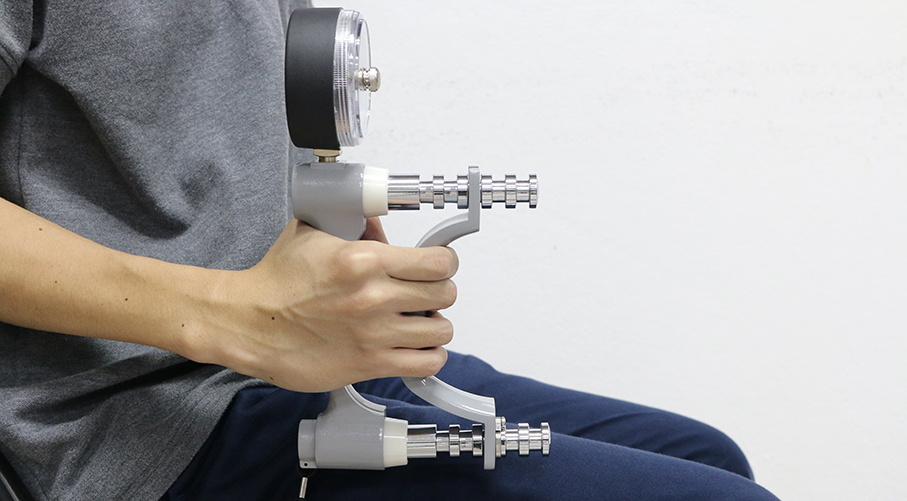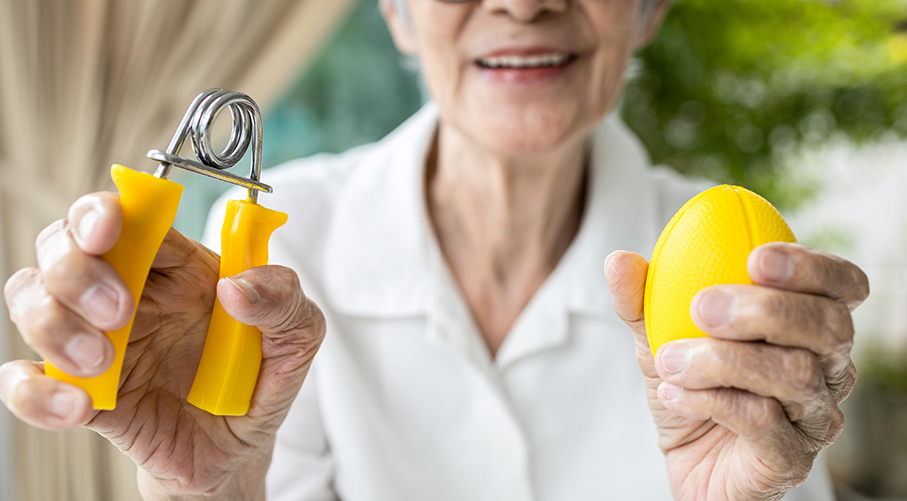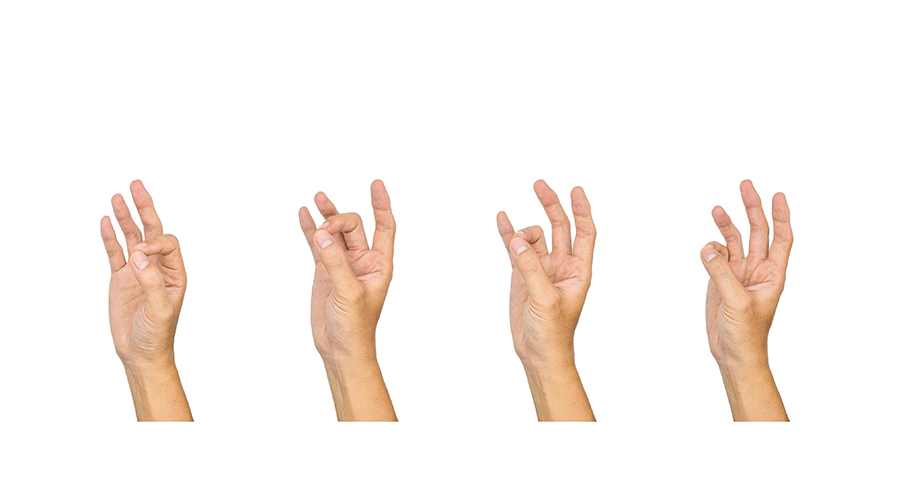To protect our hands and wrists from injury, pain, and symptoms of arthritis, it is important to strengthen our dynamic wrist, finger, and thumb muscles. By improving the strength of our hands and wrists not only do we reduce pain, but also, we improve muscular endurance, dexterity, and fine motor skills. Strong hands are better able to do all the complex tasks we rely on them to do. This results in a better quality of life. Maintaining strong hands and wrists helps to prevent and delay the onset of arthritis in our hands. And, intriguingly, improved grip strength is a sign of overall better health.
Here at CHARMS, our Hand Care Team can show you how to protect your hands and wrists by keeping them strong.

Overview
Wrist, Finger, and Thumb Muscles
When we make a fist, twist open a jar, turn a key, or grip a steering wheel, we use a complex combination of the 30 intricate muscles in our hands. Our hand muscles give us great dexterity, range of movement, and precision for accomplishing many tasks throughout our day.
Hand movement is often started by muscles in the forearms that run through the palm and back of the hand. Short muscles lie between the individual bones of the hand. Powerful groups of muscles, the thenar eminence at the base of the thumb, and the hypothenar eminence on the little finger side of the hand enable our thumb to touch our fingertips.
Strong muscles in our hands give us power grip to carry heavy objects such as lifting a mug or jug of juice, carrying groceries, and picking up children. We also have precision grip, our ability to control the powerful muscles in the hand. This allows us to play intricate instruments, write and draw, thread a needle, and pick up tiny objects.
Risk Factors Related to Declining Hand Strength
Our muscles provide protection for our bones and joints. Strong hand and wrist muscles keep our joints in alignment allowing our bones to move smoothly and comfortably. When our hand muscles are weak, they are less able to protect our bones and joints, whether our hands are at rest, work, or play. This makes our bones and joints more susceptible to injury and damage.

Why Upper-Limb Strength is Important
Overworked hands and wrists endure stress and strain which can cause pain. Maintaining hand strength increases the limits our hands can work at, which reduces pain. Similarly, weakness in our hands can cause wear and tear on our joints. And wear and tear on our delicate hand structures and joints can lead to problems like arthritis.
Overview of Types of Hand-Strengthening Exercises and Equipment
For each area of our hands, our wrists, fingers, and thumbs, there are strengthening exercises to help keep our hands strong, flexible, and pain and injury free. The therapists at CHARMS recommend being creative with your exercises. Household items like a table, hammer, broom, or umbrella can be used to help strengthen your hands. For dedicated hand strengthening, there are cleverly designed items that target specific hand muscles with advantageous exercises to practice.
Talk to your CHARMS hand specialist about which equipment is right for you. Some of the strategic hand-strengthening equipment like putty, twisty bars, and resistance bands are available for sale through CHARMS.
Benefits of Wrist, Finger, and Thumb Strengthening
How Does Strengthening Help Prevent Hand Injuries?
Building strong muscles supports the delicate hand structures, joints, tendons, and bones. Injuries happen when our muscles are fatigued, often due to overtaxing and overworking our muscles. By strengthening the muscles in our hands, we increase loadbearing and work capacity. Our stronger muscles keep our bones and joints in alignment, so our dexterous hands move properly and efficiently. This helps to prevent and decrease injury while increasing performance. It also helps to increase range of motion and mobility, giving our hands more flexibility.

Strong Hands and Wrists Aids Arthritis Prevention.
Early symptoms of arthritis are often stiffness, pain, and loss of motion. Osteoarthritis is a common form of arthritis which is caused by the natural wearing away of the rubbery cartilage found protecting our bones and joints. Healthy joints have cartilage at the ends of bones where they meet, allowing for smooth, comfortable gliding action when our joints move.
Once cartilage is gone, sadly it cannot be rebuilt. But performing hand exercises helps to preserve motion and keep the soft tissue in our joints as supple as possible. Maintaining hand function with hand exercises has shown to improve grip strength and reduce pain and fatigue as well.
Improved Strength Equals Reduced Pain
Doing hand strengthening exercises improves strength and flexibility, preparing your hands for the demands of day-to-day tasks. The strong muscles surrounding your joints and bones act as protection, allowing them to be more mobile. Strong muscles support our hardworking joints, so they can move more effectively with less pain. Regular gentle exercise, interestingly, has anti-inflammatory effects which reduces pain and stiffness symptoms. And exercise improves blood flow through your hands, wrists, fingers, and thumbs. This distributes more oxygen and nutrients to your muscles, letting them produce the energy they need to perform our day-to-day activities.
Muscular Endurance, Dexterity, and Fine Motor Skills for Better Quality of Life.
Improved hand strength results in longer lasting muscular endurance, meaning our hands fatigue less easily. Not only does this help to prevent injury, but it also allows us to continue hobbies we love like sewing, playing musical instruments, typing, drawing, as well as many sports activities such as golf or rock climbing. Maintaining muscle strength in our hands also maintains our coordination. Preserving our dexterity and fine motor skills lets us grasp and manoeuvre small objects and demonstrate precise movements. Coordinated tasks like opening or closing zippers or buttoning a shirt, opening the toothpaste, or eating with chopsticks are made easier with improved hand strength. Performing our daily tasks with ease makes for a better quality of life.

Grip Strength, A Road to Better Health
A device used to measure grip strength, called a dynamometer, is used to determine overall muscular strength in adults. In a Prospective Urban Rural Epidemiology (PURE) study published in May 2015, 142, 861 adults from 17 countries had their grip strength measured over a 4-year period. The study concluded, “Grip strength was a stronger predictor of all-cause and cardiovascular mortality than systolic blood pressure”. Better health is associated with a higher grip strength, and a lower grip strength may signal poorer health. This idea shows that our grip strength reveals not only the strength of our grip and power in our hands, wrists, and forearms, but it also indicates how healthy our whole body is.

Hand Strengthening in Action
Exercises and Equipment for Strong Wrists
Everyday household items like a table, hammer, or umbrella can be used to strengthen your wrists. When getting started, certain equipment like dumbbells, weights, resistance bands, or twisty bars can help you learn beneficial movements and exercises.
Description and Benefits
Wrist exercises increase strength and power in the wrist while promoting endurance and flexibility. This helps to avoid repetitive strain injury. Gentle wrist exercise can help recover and improve range of motion after an injury as well. It is important to warm up before exercising your wrists. This improves circulation so your muscles and joints get the most benefit from your efforts.
Wrist Extension and Flexion Exercise
This exercise can be done with or without a weight. A 1-to-4-pound dumbbell can be used. Alternatively, a can of soup, water bottle, or household item that is the right weight and fits nicely in your hand will work. It may be right for you to start slowly, so you can do these exercises without a weight as well.
Extension
While sitting, rest your forearm on a table with your wrist hanging over the edge. Make a fist or hold a weight with your hand. With your palm facing down, slowly and with control, lift your hand towards the ceiling, leaving your forearm on the table. Hold the upward position for a few seconds and slowly lower your hand. Repeat 10 to 15 times and perform 2 to 3 sets per hand.
Flexion
In the same position, turn your palm upwards. Flex your wrist so your palm moves towards the ceiling. Again, hold the position for 2 to 3 seconds and slowly lower your hand back down. Repeat 10 to 15 times and perform 2 to 3 sets per hand.
Finger-Strengthening Exercises and Equipment
Finger strengthening exercises can be accomplished by simply squeezing your own muscles. Dedicated equipment like thick rubber bands, spiderweb, putty, or towels are excellent to help strengthen the little muscles in the fingers.

Description and Benefits
Enjoyable activities like playing piano or the violin or sports such as rock climbing each help strengthen fingers. At the same time, our performance in these types of activities is improved with strong fingers.
Finger Hooks
This simple exercise does not require any equipment. In front of your chest, place your hands, one palm up and one palm down. Hook your fingertips together. Use your arms to pull in an outward motion while maintaining the finger hooks. Hold for 5 seconds and relax. Repeat 10 to 20 times. Switch hands top to bottom, and bottom to top. Repeat exercise.
Thumbs Up for Exercises and Equipment for Strong Thumbs
Exercising our thumb muscles can be as simple as making the good sign. Pinching and gripping exercises help build strength in the larger thumb muscles. Equipment includes using a strengthening ball, or a resistance band. Using cloth pegs is also helpful. The hand therapists at CHARMS can show you how to modify the cloth peg to maximise your thumb strengthening experience.

Description and Benefits
Our thumbs account for almost half of our hand function. We rely on them for so many daily tasks of pinching and griping. Stronger, more flexible thumbs give us the strength and dexterity for all the things our hands love to do.
The Good Sign
With the goal of making a perfect ‘O’ shape with our thumb and fingers, this exercise helps open the web space of our thumb. It contracts several thumb muscles to help increase the thumbs mobility and stability.
Gently and without pain, touch the tip of the index finger to the tip of your thumb while forming a perfect ‘O’ with your thumb and finger. Open the fingers and thumb all the way to fully straighten the hand. Repeat the good sign with the middle finger, and then fully opening your hand. Repeat the movement with the ring finger and little finger. Don’t forget to rest. Repeat as needed.
How CHARMS Can Help
The Hand Care Team at CHARMS and their dedicated Hand Therapists can show you how to protect your hands and wrists and ways to keep them strong. In addition, the Hand Care Team at CHARMS will recommend exercises and equipment perfect for your unique hand care. With the knowledge and experience to create the right hand-strengthening exercises for you, the Hand Therapists at CHARMS are here to help.